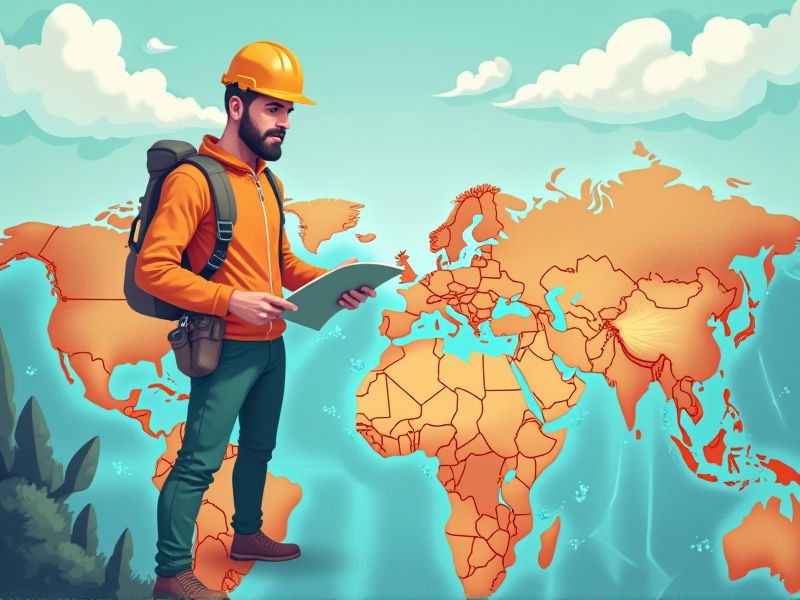
To excel at GeoGuessr, one must approach it with a mindset akin to lifelong learning, as Peter Drucker once noted, "We now accept the fact that learning is a lifelong process of keeping abreast of change" . This mindset is crucial because GeoGuessr requires continuous learning about new locations and features, especially as Google updates its coverage. Pro players like Trevor Rainbolt emphasize the importance of recognizing details such as telephone poles, road types, and vegetation to make educated guesses . By dedicating time to study these elements, players can significantly improve their skills and become more accurate in their location guesses.
How To Be Better At GeoGuessr
Analyze environmental clues
Observing subtleties like vegetation, architecture, and signage directly influences your ability to pinpoint geographic regions. Noticing regional differences in flora, road conditions, and design patterns provides actionable data that narrows down potential locations. Interpreting environmental nuances, such as variations in climate indicators or built environment features, translates into more informed guesses and pathways during gameplay. Focusing on these details not only builds your geographic intuition but also helps you apply empirical data to each new scenario in geoguessr.
Develop map-reading skills
Developing strong map-reading skills directly enhances your ability to interpret and analyze geographical features in Geoguessr. Recognizing patterns in urban layouts, natural formations, and road networks allows you to narrow down potential regions quickly. Regular practice with online maps and engaging in exercises focused on identifying key landscape markers can significantly boost your strategic guessing accuracy. This targeted improvement in map-reading proficiency creates a measurable advantage when navigating through diverse virtual environments in the game.
Improve street view navigation
Focus on learning the unique characteristics of different regions, such as road structures, vegetation, and architecture, to make quicker deductions while navigating through street view. Recognize that enhanced spatial awareness and familiarization with Google Street View controls result in sharper location estimates. Incorporate practice sessions in diverse environments to develop a more intuitive grasp of the geographical clues presented. Understand that consistent, mindful observation of environmental details will improve your navigation skills and overall performance in Geoguessr.
Study regional landmarks
Study regional landmarks to enhance your GeoGuessr performance because each region's characteristic features act as geographical signposts. Recognizing unique styles in architecture, vegetation, and road signs can narrow down locations significantly. This targeted knowledge accelerates decision-making and minimizes random guessing. Consequently, investing time in understanding these landmarks directly boosts your accuracy and overall gameplay efficiency.
Recognize language indicators
Language indicators act as geographical clues, guiding you toward regions where particular phrases or characters are commonly used. Observing unique scripts, such as Cyrillic or Arabic, can quickly narrow down the potential locations by linking them to specific parts of the world. When you immediately associate stylistic elements or road signage text with known languages, it increases your estimation accuracy in GeoGuessr. This acute recognition leads to a faster decision-making process, enhancing your overall gameplay performance.
Observe climate and vegetation
Observing the local climate and vegetation provides tangible clues about the region's latitude and biome. Noting elements like dry, arid grasslands versus lush, tropical forests can quickly narrow down potential locations. Specific plant species often correlate with certain climates, so recognizing these patterns directly informs your geographical deductions. By integrating these environmental cues with your broader knowledge of global regions, you can make more informed and accurate guesses in GeoGuessr.
Compare architectural styles
Understanding regional architectural styles serves as a powerful tool for narrowing down locations in Geoguessr. Noticing features like ornate carvings or unique roof designs can reveal a building's cultural and historical context, which in turn aids in pinpointing its geographical origin. Comparing different styles--for example, the intricate designs of European townhouses versus the streamlined features of North American constructions--directly influences your ability to deduce regional clues. Analyzing these architectural details systematically increases your chances for accuracy by providing clear, data-driven visual cues.
Identify road and vehicle cues
Observing road markings, signage styles, and lane patterns can quickly narrow down potential regions, as different countries often have unique systems. Vehicle models, license plate designs, and even vehicle conditions provide cultural and geographic hints that align with specific markets. Pay attention to public transportation styles since buses, taxis, and regional car features often reflect local regulations and available technology. Combining detailed analysis of these road and vehicle cues with contextual clues significantly enhances your GeoGuessr accuracy and overall gameplay strategy.
Practice diverse rounds
Exploring various regions through diverse rounds boosts your ability to decipher unique environmental clues. Diverse rounds expose you to a wide range of geographic features that improve spatial pattern recognition over time. The consistent practice across different settings strengthens your decision-making by forcing you to adjust your strategy based on new data. Analyzing performance metrics from varied rounds often shows a clear improvement in pinpoint accuracy and overall game efficiency.
Expand geographical knowledge
Studying regional landmarks and reading up on distinct ecosystems increases your ability to decode subtle hints in unfamiliar landscapes. Recognizing differences in architectural styles and street signage leads to better identification of specific countries or regions. Familiarizing yourself with climatic conditions and natural formations lets you infer where a location might be, improving your guessing accuracy. Integrating targeted research and continuous practice with interactive maps ultimately builds a robust mental database for Geoguessr gameplay.
Summary
Strong analysis of environmental clues enables players to identify subtle hints like vegetation types, architectural styles, and road markings, which in turn narrow down the geographic possibilities. Developing map-reading skills means players can interpret spatial data and geographic layouts, directly increasing their precision when pinpointing locations. Enhanced street view navigation provides users with the ability to explore surroundings more methodically, making it easier to connect physical details with known global patterns. Combining these improved techniques directly translates into more informed guesses and superior performance in Geoguessr.
